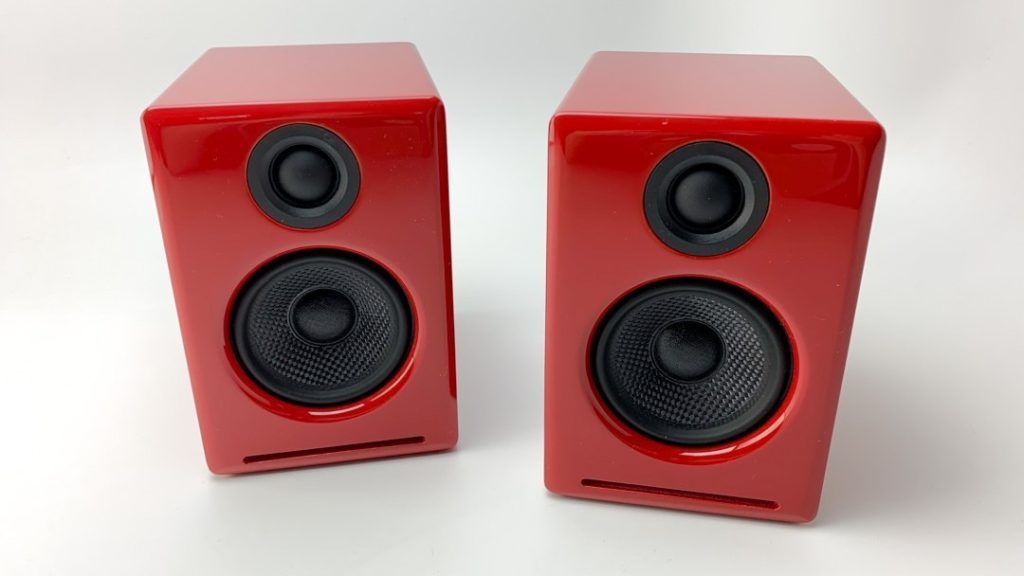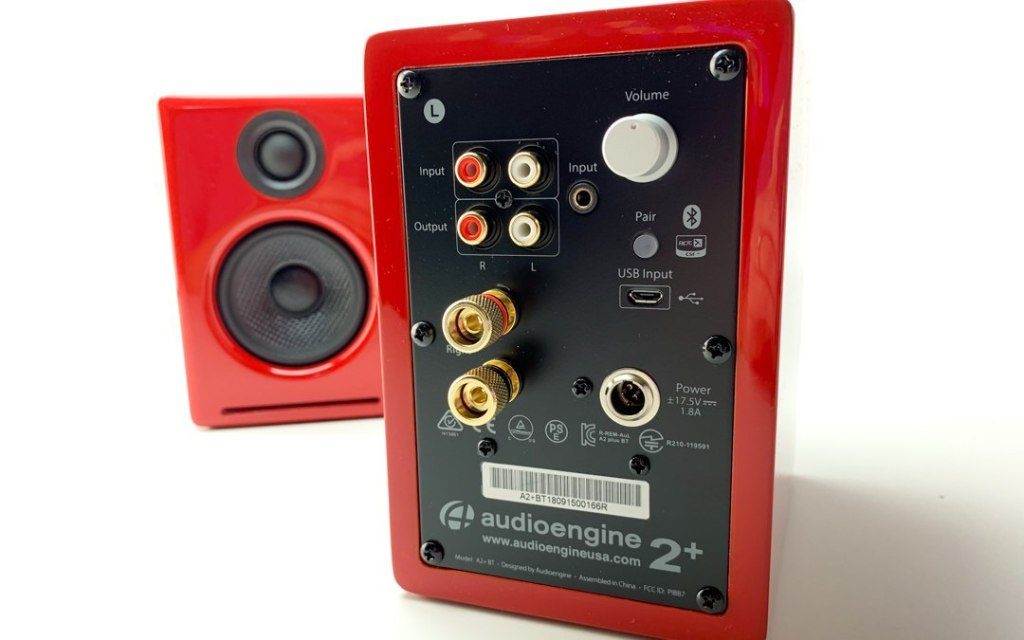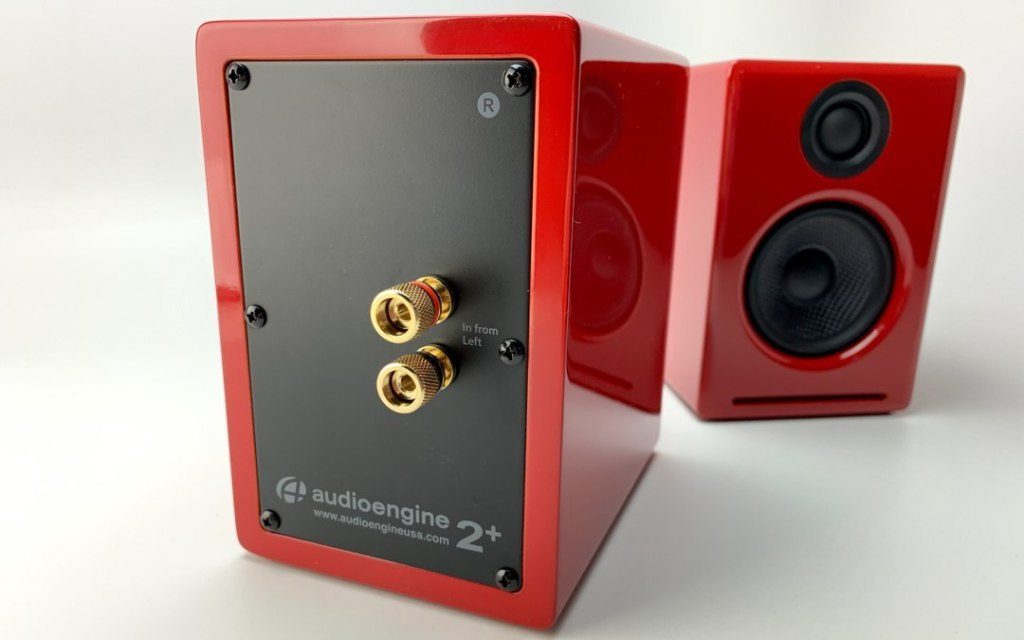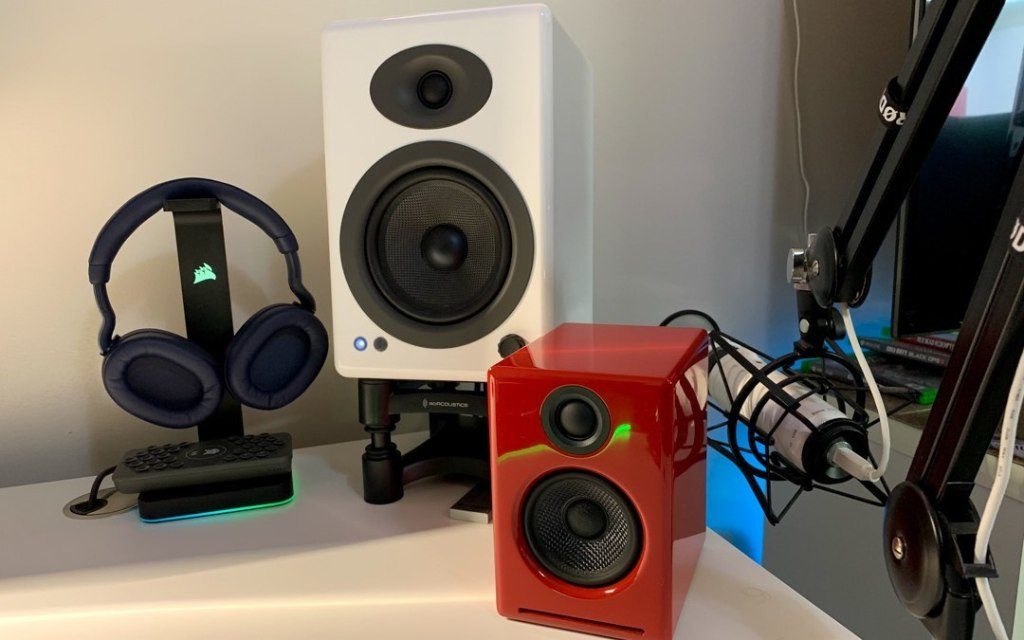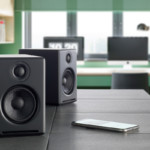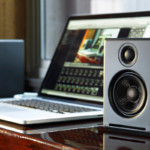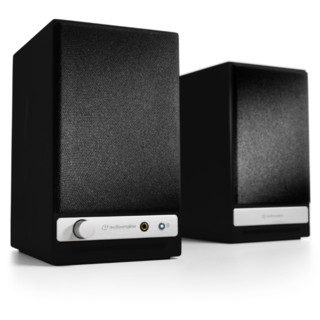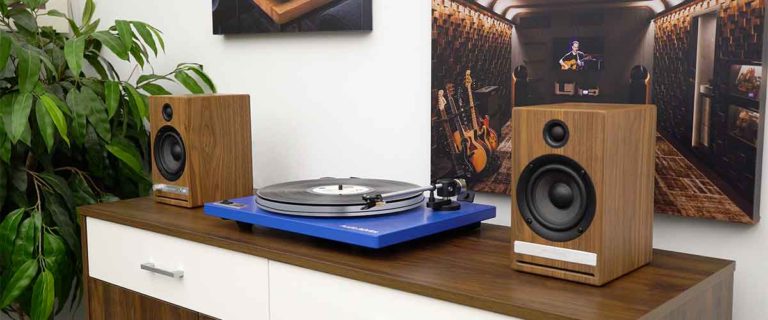Speakers provide an upgraded sound experience for connected devices.
It’s been more than seven years since I lived alone. Since that time, I’ve sort of felt like a wandering nomad when it comes to my workspace. I’ve always had somewhere to work, but never something to call ‘home’. My primary computer is a laptop and it’s connected to an external monitor, keyboard, and wireless mouse. I’ve struggled with finding the ‘right’ speakers for this set-up because it’s a smaller workspace and there isn’t much desk real estate involved. A couple of years ago, I had the opportunity to try out the HD3 Wireless Speakers from Audioengine. They were a good fit for me for a while, but eventually, the workspace outgrew those speakers as well. They were 7-inch speakers and I realized that I just wanted something a little more compact — but I didn’t want to sacrifice sound quality or power. So, I turned back to Audioengine when I began resetting my workspace and have added the A2+ Wireless Speaker System to my set-up.
Details
- Courtesy of Mac Sources
- Courtesy of Mac Sources
- Courtesy of Mac Sources
- Courtesy of Mac Sources
- Courtesy of Mac Sources
- Courtesy of Mac Sources
The A2+ speakers are a 2-speaker system that is designed to provide clear, full stereo sound.
Audioengine refers to the speakers as a ‘mini music system’ that is great for desktop set-ups or smaller rooms. The speakers are sold in pairs and there are three finish choices — Satin Black, Hi-Gloss Red, and Hi-Gloss White. The speakers feature advanced Bluetooth connectivity, USB Audio Input, dual analog audio inputs, silk tweeters, and aramid fiber woofers, and a subwoofer output. The A2+ system can connect directly to a Mac, PC, phone, or other any other device through 3.5mm or RCA inputs. It has aptX HD Bluetooth codec and a 24-bit Digital DAC so that the music bypasses the low–quality sound card in your connected device and you are always provided a premium sound. The speakers come with 2m speaker wire, power supply, and cord, 1.5m mini-jack audio cable, microfiber speaker bags, and a set-up guide.
- Type: 2.0 powered (active) multimedia desktop speaker system
- Amplifier type: Dual-class AB monolithic
- Power output: 60W peak power total (15W RMS / 30W peak per channel), AES
- Drivers: 2.75″ aramid fiber woofers, 3/4” silk dome tweeters
- Inputs: 3.5mm stereo mini-jack, RCA, USB, Bluetooth
- Outputs: RCA variable line-out
- Mains voltages: 100-240V 50/60Hz auto-switching
- SNR: >95dB (typical A-weighted)
- THD+N: <0.05% at all power settings
- Crosstalk: <50dB
- Freq. response: 65Hz-22kHz ±2.0dB
- Input impedance: 10K ohms unbalanced
- Protection: Output current limiting, thermal over-temperature, power on/off transient protection
- Connector type: Micro USB
- USB device class: type 1.1 and above
- Internal D/A converter: CSR8670
- Input bit depth: up to 16 bits native
- Input sample rate: up to 48KHz native
- Internal BT receiver: CSR8670
- Input bit depth: 16 bits
- Bluetooth receiver type: Bluetooth 5.0 audio
- Supported codecs: aptX low latency, aptX, AAC, SBC
- Wireless operation range: Up to 100ft (30m) typical
- Input data rate: Determined by Bluetooth
- Wireless latency: ~30 milliseconds (ms)
- Dimensions (each): 6”(H) x 4”(W) x 5.25”(D)
- Weight (LEFT speaker): 1.6Kg/3.55lbs
- Weight (RIGHT speaker): 1.4Kg/3.15lbs
- Shipping weight: 4.6kg/10lbs per pair
- Shipping box dims: 10.5” (H) x 15” (L) x 7” (W)
- 18mm thick MDF cabinets
- 3/4″ (20mm) silk dome tweeters with neodymium magnets
- 2.75″ aramid fiber woofers with advanced voice coils
Impressions
One of the things I loved so much about the HD3 speakers was how easy they were to set-up. Well, the same is true of the A2+ speakers. Even though you have the option of adding in a subwoofer, the system has enough power on its own to provide a strong, rich sound with just about any type of media thrown at it. As described above, my set-up is pretty minimal in nature. I intended to use speakers wirelessly from the beginning. So, for me, the set-up was to connect power to the left speaker where the power input resides and then string the speaker wire between the two speakers. After that, I simply had to connect the speakers to my laptop in the Bluetooth preference menu and voila! I was listening to rich, full music with a smaller footprint on my desktop, which was my goal from the start.
I really have very few issues with these speakers.
They are the little brother to the A5+ speakers and actually look like a miniature version of them. Unless you want to move up to a larger speaker, the 60W peak total is pretty standard across the board with Audioengine’s speaker lineup. The larger speakers have a peak total of 150W, but they are quite larger physically and for me, I won’t sacrifice desk space for a larger size since these smaller speakers are powerful enough for me.
I do love the design of the A2+ speaker with one exception — the volume control. The volume control knob is located on the back of the left speaker along with the input/output ports. I would have loved to see this be moved around the front of that same speaker especially since it works independently of paired sound sources. The A5+ has a volume control knob and a pairing button located on the front and it would have been great to see the A2+’s mimic that design feature. This system also does not come with a remote control, which is a bit of a hindrance at times. Again, I would have loved this feature to carry over from the A2+’s big brother — especially since the volume control is on the back of a speaker.
As far as performance goes, I did my primary testing using a MacBook Pro (13-inch, 2016) connected wirelessly. Because the speakers are so short, I purchased a set of speaker stands that AudioEngine designs for the A2+ and HD3 speaker systems. They are small, silicone rubber wedges that will angle the speakers upward at a 15º angle. In addition to providing the angle for a better listening experience, the rubber also reduces vibration between the speakers and your desktop. The best part is they are only $29. I do wish that these were included or at least an option to add-on as a package deal when you order the speakers. All-in-all, I found that the A2+ speakers provided a substantial upgrade to connected audio systems. For example, playing music out of the built-in speakers of my MacBook Pro is not a preferred listening experience as the music just falls flat. With the A2+ speakers connected, however, music tracks were full, rich and sometimes unexpectedly wonderful.
Final Thoughts
While I haven’t tried all the speakers of this size in this category, I do favor the A2+ speakers from Audioengine. I feel that for their price point ($269) and feature set, they are the clear choice if you are looking for powerful, compact speakers for a desktop. I do recommend adding on the Audioengine DS1 Desktop Stands for the speakers so that they can be pointed toward you. That way you get the most out of your listening experience. I’ve not had any issues with wireless connectivity and the sound quality is way above average. Even though some audiophiles might prefer to invest in the larger A5+ speakers, the A2+ speaker system are an incredible option for someone who wants to beef up their set-up with a premium set of smaller speakers.
Read the full review here.


